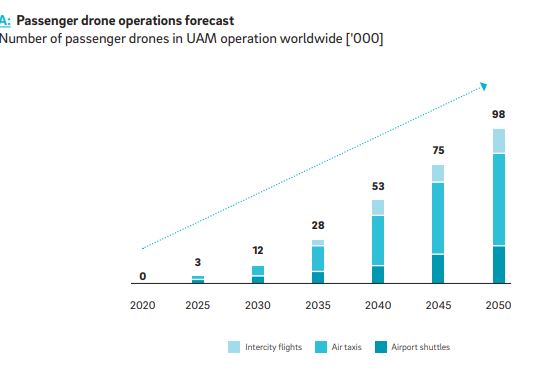Roland Berger’s November report on the Urban Air Mobility market (Urban air mobility The rise of a new mode of transportation) forecasts that close to 100,000 passenger drones could be in the air worldwide by 2050. “Something like 100 cities worldwide will have implemented drone services to provide a variety of passenger transport services by then, with on average 1,000 passenger drones in operation in each city. However, there will be a large spread of drones per city ranging in 2050 from 60 drones for the smallest metropolitan areas to more than 6,000 in the largest ones. Based on this scenario, drones will become an integral part of urban (and supra-urban) mobility offerings over the next three decades.”
According to the consultant, three key developments over the next decade will be instrumental in shaping the evolution of the UAM market: Improvements in battery technology and new forms of electric propulsion will increase flight ranges from 20 to 30 kilometers today to more than 100 to 250 kilometers by 2030.
“In our opinion, the rough timeline for these developments will look something like this:
- INITIAL PILOT PROJECTS IN THE EARLY 2020s The first pilot projects will get off the blocks in the early 2020s. Dubai, Singapore, Dallas, Los Angeles and Tokyo, five pioneers of urban air mobility, are keen to provide proof of concept, generate publicity and deliver positive user experiences. Dubai commenced test flights in 2017 and has an ambitious goal of launching commercial operations of its Autonomous Aerial Taxi Service in the near future. Which corresponds to RTA’s objective of making 25 percent of all public transport modes autonomous by 2030. Uber Elevate project should go live in Los Angeles, Dallas and a third international city starting in 2023. These services will have human pilots, a short range of 20 to 50 kilometers and a focus on intracity mobility.
- RANGE EXPANSION AND TECHNOLOGICAL ADVANCES THROUGH 2030 Between 2025 and 2030, eVTOL technology will continue to progress rapidly and expand its geographic reach. Lift and cruise and tilt-wing technologies will combine with more durable batteries to let vehicles fly up to 100 to 250 kilometers and carry three to five passengers. Urban air taxi services will spread to more megacities around the globe and, thanks to their increased range, will also be deployed in the suburban commuting market. Technology, business/operating models and the corresponding infrastructure will continue to improve and regulatory gaps will be closed. Flights should be autonomous to an increasing extent, though commercial passenger drone operators might still keep a pilot on board for safety reasons.
- AUTONOMOUS FLIGHTS AFTER 2030 The third stage will see autonomous flight technology
In terms of the regulatory challenge, Roland Berger says:
“One of the key hurdles right now is the absence or very immature status of regulations worldwide. As things stand, there is no dedicated body of law in place to govern the operation of drone taxis. Yet a comprehensive regulatory framework will be essential to guarantee the safety of people, infrastructure facilities and third-party property. This will clearly be another crucial success factor if the UAM market is to take wing. Such a regulatory framework should, in our opinion, address four key safety concerns: avoidance of possible mid-air collisions, prevention of injuries to people and damage to properties as an outcome of possible crashes, and avoidance of privacy breaches. Its inevitable objective is therefore to regulate the certification of vehicles, operators, air traffic management (ATM) and, indeed, the entire airspace for UAM services.”
For more information
https://www.rolandberger.com/en/Publications/Passenger-drones-ready-for-take-off.html




